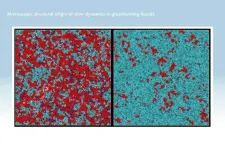(Press-News.org) Declining blood levels of two molecules that occur naturally in the body track closely with worsening Alzheimer’s disease, particularly in women. Levels were found to drop gradually, from women with no signs of memory, disorientation, and slowed thinking to those with early signs of mild cognitive impairment. Decreases were more prominent in women with moderate or severe stages of the disease. Declines in men were evident in only one molecule, revealing a disease-specific difference between the sexes.
Six million Americans, most over the age of 65 and predominantly women, are currently estimated to have some form of Alzheimer’s disease.
Led by neuroscientists at NYU Langone Health, in collaboration with other researchers in the U.S. and Brazil, the new study showed that blood levels of the protein acetyl-L-carnitine were lower in both women and men with mild cognitive impairment and Alzheimer’s disease. Blood levels of free carnitine, the main byproduct of acetyl-L-carnitine in reactions essential to brain function, steadily declined in women in amounts related to the severity of their cognitive decline. In men, significant declines were seen only in acetyl-L-carnitine, not free carnitine.
Published in the journal Molecular Psychiatry online Jan. 7, the study results suggest that declines in these two brain chemicals could indicate the presence and degree of Alzheimer’s disease, and that this difference might offer an explanation as to why women are at higher risk of the disease than men.
Additional computer testing showed that blood levels of acetyl-L-carnitine and free carnitine aligned in direct proportion in study participants to increased amyloid beta and tangled tau protein levels, long considered markers of progressive severity in Alzheimer’s disease. Indeed, the research team’s accuracy in diagnosing the severity of Alzheimer’s disease rose from more than 80% – when using either amyloid beta and tangled tau protein levels collected from cerebrospinal fluid or the two blood molecules – to 93% when using both.
“Our findings offer the strongest evidence to date that decreased blood levels of acetyl-L-carnitine and free carnitine could act as blood biomarkers for identifying those who have Alzheimer’s disease, and potentially those who are at greater risk of developing early dementia,” said study lead investigator Betty Bigio, PhD. “The results also might explain the differences by sex in Alzheimer’s disease, with more women than men having dementia,” said Bigio, a research assistant professor in the Department of Psychiatry at NYU Grossman School of Medicine. Bigio is also affiliated with the Nathan Kline Institute for Psychiatric Research.
“Because declines in acetyl-L-carnitine and free carnitine tracked closely with the severity of Alzheimer’s disease, the molecular pathways involved in their production offer other possible therapeutic targets for getting at the root cause of the disease and potentially intervening before permanent brain damage occurs,” said senior study investigator Carla Nasca, PhD. Nasca is an assistant professor in the Departments of Psychiatry and Neuroscience at NYU Grossman School of Medicine. Nasca is also affiliated with the Nathan Kline Institute for Psychiatric Research.
The study involved data on two separate groups of men and women in Brazil and California, in which the researchers measured blood levels of the two molecules. A total of 93 study volunteers diagnosed with varying degrees of cognitive impairment were involved, along with 32 cognitively healthy men and women of similar age, weight, and education. Results in the Californian group were used to confirm what was found in the Brazilian group.
Moving forward, Nasca says more research is needed into the root sources of acetyl-L-carnitine and the molecular pathways that control its production and into tracking how the molecule affects brain chemistry as it is contained in brain vesicle stores released into the blood. The team’s goal is to define other biomarkers in the brain that track closely with Alzheimer’s disease progression.
If further studies confirm their latest findings, Nasca says the team’s research could be used to develop a blood test for dementia and for tracking the progression of Alzheimer’s disease in an easier and noninvasive way. Currently, searching for biomarkers of disease progression can involve serial spinal taps that pose risks of pain and infection. A blood test might also be useful to support or add a more objective, quantitative measure of disease severity than existing questionnaires that test memory or thinking skills.
A blood test, Nasca says, could also help predict the effectiveness, or lack thereof, of potential new drug treatments designed to delay or prevent the onset of Alzheimer’s disease.
Both acetyl-L-carnitine and free carnitine are essential for healthy brain function and regulating cell energy metabolism. Past research by Nasca’s team showed that acetyl-L-carnitine also shuttles molecules from a cell’s powerhouse mitochondria to a cell’s controlling nucleus, allowing genes to open and become activated. This shuttling action is key in regulating genes that produce the neurotransmitter glutamate, another chemical involved in most brain activities, including nerve cell repair (plasticity). This matters in the hippocampus region of the brain, which helps regulate memory and where initial damage from Alzheimer’s diseases is known to appear.
Nasca says that excessive levels of glutamate have also been tied to mood disorders and severe cases of depression in humans, disorders closely tied to Alzheimer’s disease. Her team has also linked deficiencies in acetyl-L-carnitine, but not free carnitine, to depression and childhood trauma. Future investigations are planned about how to prevent the progression of depression to Alzheimer’s disease.
Funding support for the study was provided by National Institutes of Health grants R24AG06517, P50AG16573, and P30AG066519. Additional funding support came from the Robertson Therapeutic Development Fund, D’Or Institute for Research and Education, Rede D’Or Sao Luiz Hospital Network, International Society for Neurochemistry, Fundacao Carlos Chagas Filho de Ampara a Pesquisa do Estado do Rio Janeiro, Serrapilheira Institute, and Alzheimer’s Association grant AARG-D-61541.
Besides Bigio and Nasca, other NYU Langone researchers involved in the study are co-investigators Aryeh Korman and Drew Jones. Other study co-investigators are Ricardo Lima-Filho, Felipe Sudo, Claudia Drummond, Naima Assuncao, Bart Vanderborght, Sergio Ferreira, Paulo Mattos, Fernanda Tovar-Moll, Fernanda De Felice, and Mychael Lourenco, at the Federal University of Rio de Janeiro and the D’Or Institute for Research and Education, also in Brazil; Olivia Barnhill, at Rockefeller University in New York City; James Beasley and Sarah Young, at Duke University in Durham, N.C.; and David Sultzer and Elizabeth Head, at the University of California Irvine.
###
About NYU Langone Health
NYU Langone Health is a fully integrated health system that consistently achieves the best patient outcomes through a rigorous focus on quality that has resulted in some of the lowest mortality rates in the nation. Vizient, Inc., has ranked NYU Langone the No. 1 comprehensive academic medical center in the country for three years in a row, and U.S. News & World Report recently placed nine of its clinical specialties among the top five in the nation. NYU Langone offers a comprehensive range of medical services with one high standard of care across six inpatient locations, its Perlmutter Cancer Center, and more than 300 outpatient locations in the New York area and Florida. With $14.2 billion in revenue this year, the system also includes two tuition-free medical schools, in Manhattan and on Long Island, and a vast research enterprise with over $1 billion in active awards from the National Institutes of Health.
Media Inquiries:
David March
212-404-3528
David.March@nyulangone.org
STUDY LINK
https://www.nature.com/articles/s41380-024-02862-5
END
Study advances possible blood test for early-stage Alzheimer’s disease
- Findings may explain why women are at higher risk
2025-01-08
ELSE PRESS RELEASES FROM THIS DATE:
New international research collaboration to develop and test an improved dietary supplement for pregnant women
2025-01-08
New international research collaboration to develop and test an improved dietary supplement for pregnant women
Poor nutrition during pregnancy can have serious consequences for both maternal and child health. A new research collaboration – ‘Mother’s Micronutrient Supplement for Pregnancy and Lactation’ (MoMS) – between researchers in Kenya, Norway and Denmark aims to develop and test a new, improved dietary supplement to reduce incidences of low birth weight, improve maternal and child health, and enhance growth and cognitive development in children. MoMS ...
Presenting a path forward for future genetically-modified pig heart transplants: lessons learned from second patient
2025-01-08
Continuing significant advancements in the field of xenotransplantation, surgeon-scientists from the University of Maryland School of Medicine provided an extensive analysis on the second patient in the world to receive a genetically-modified pig organ. Lawrence Faucette, 58, received a pig heart at the University of Maryland Medical Center in 2023 to treat his end-stage heart failure. He lived for 40 days before choosing to forgo additional treatment after the transplant began to fail due to rejection.
The report documenting insights ...
When the past meets the future: Innovative drone mapping unlocks secrets of Bronze Age ‘mega fortress’ in the Caucasus
2025-01-08
A Cranfield University, UK, academic has used drone mapping to investigate a 3000-year-old ‘mega fortress’ in the Caucasus mountains. Dr Nathaniel Erb-Satullo, Senior Lecturer in Architectural Science at Cranfield Forensic Institute, has been researching the site since 2018 with Dimitri Jachvliani, his co-director from the Georgian National Museum, revealing details that re-shape our understanding of the site and contribute to a global reassessment of ancient settlement growth and urbanism.
Fortress settlements in the South Caucasus appeared between 1500-500 BCE, and represent an ...
AI could improve the success of IVF treatment
2025-01-08
During IVF treatment, doctors use ultrasound scans to monitor the size of follicles - small sacs in the ovaries containing eggs - to decide when to give a hormone injection known as the ‘trigger’ to prepare the eggs for collection and ensure that they are ready to be fertilised with sperm to create embryos. The timing of the trigger is a key decision, as it works less effectively if the follicles are too small or too large at the time of administration. After the eggs are collected and fertilised by sperm, an embryo is then selected and implanted into the womb to hopefully lead to pregnancy.
Researchers used ‘Explainable ...
Moving in sync, slowly, in glassy liquids
2025-01-08
Tokyo, Japan – Glass might seem to be an ordinary material we encounter every day, but the physics at play inside are actually quite complex and still not completely understood by scientists. Some panes of glass, such as the stained-glass windows in many Medieval buildings, have remained rigid for centuries, as their constituent molecules are perpetually frozen in a state of disorder. Similarly, supercooled liquids are not quite solid, in the sense that their fundamental particles do not stick to a lattice ...
Climate change linked with worse HIV prevention and care
2025-01-08
Toronto, ON – New challenges in HIV prevention and care are emerging due to climate change, according to a review published earlier this month in Current Opinions in Infectious Disease.
Researchers from the University of Toronto analyzed 22 recent studies exploring HIV-related outcomes in the context of climate change and identified several links between extreme weather events and HIV prevention and care.
Climate change-related extreme weather events, such as drought and flooding, were associated with poorer HIV prevention outcomes, including ...
Exeter launches second round of global funding to tackle antifungal drug resistance
2025-01-08
A University of Exeter funding scheme designed to combat the global challenge of fungal antimicrobial resistance (fAMR) has announced a new call for applications.
The FAILSAFE project (Fungal AMR Innovations for LMICS: Solutions and Access For Everyone) is a groundbreaking initiative tackling antifungal drug resistance. The project aims to promote worldwide innovations to tackle the global health threat of fungal infections in humans, plants and animals increasingly growing resistant to available treatment.
Already, the FAILSAFE project has awarded more than £1.7 million in grants ...
Harnessing AI to respond to the global threat of antimicrobial resistance
2025-01-08
AMR is when microorganisms that cause infections, such as bacteria and viruses, change over time and no longer respond to antibiotic medicines.
It makes serious conditions such as HIV, tuberculosis and malaria more difficult to treat and increases the risk of severe illness, disease spread and death.
AMR particularly impacts low-to-middle-income countries where water quality is often poor and the spread environmental spread of AMR via wastes can be high.
In 2015 the World Health Organization (WHO) formulated a Global Action Plan to co-ordinate efforts to tackle AMR.
As a result, 194 WHO member states committed to developing country-specific ...
New findings may help researchers develop a grapefruit devoid of compounds that affect medication levels
2025-01-08
Grapefruit and pummelo contain compounds called furanocoumarins that may affect the blood levels of more than 100 prescription drugs, so that people taking these medications are advised to remove these fruits from their diets. Research published in New Phytologist reveals genetic information about the synthesis of furanocoumarins in different citrus plant tissues and species and provides new insights that could be used to develop grapefruit and pummelo that lack furanocoumarins.
The research indicates that the production of furanocoumarins in citrus ...
Advanced wearable robot eases heavy lifting and other injury-causing tasks for workers
2025-01-08
In research published in Advanced Intelligence Systems, scientists have developed an innovative, soft, wearable robot to help workers avoid job-related injuries while lifting, lowering, and carrying objects.
While many available wearable robots are limited to supporting a single degree of freedom of the body (meaning the body can only move in one direction at a given joint), the new robot, called WeaRo, operates through multiple degrees of freedom, allowing for complex movements.
In tests, WeaRo effectively reduced the muscle activation levels of lumbar, biceps, and triceps muscles by a maximum of 18.2%, 29.1%, and ...
LAST 30 PRESS RELEASES:
Making lighter work of calculating fluid and heat flow
Normalizing blood sugar can halve heart attack risk
Lowering blood sugar cuts heart attack risk in people with prediabetes
Study links genetic variants to risk of blinding eye disease in premature infants
Non-opioid ‘pain sponge’ therapy halts cartilage degeneration and relieves chronic pain
AI can pick up cultural values by mimicking how kids learn
China’s ecological redlines offer fast track to 30 x 30 global conservation goal
Invisible indoor threats: emerging household contaminants and their growing risks to human health
Adding antibody treatment to chemo boosts outcomes for children with rare cancer
Germline pathogenic variants among women without a history of breast cancer
Tanning beds triple melanoma risk, potentially causing broad DNA damage
Unique bond identified as key to viral infection speed
Indoor tanning makes youthful skin much older on a genetic level
Mouse model sheds new light on the causes and potential solutions to human GI problems linked to muscular dystrophy
The Journal of Nuclear Medicine ahead-of-print tip sheet: December 12, 2025
Smarter tools for peering into the microscopic world
Applications open for funding to conduct research in the Kinsey Institute archives
Global measure underestimates the severity of food insecurity
Child survivors of critical illness are missing out on timely follow up care
Risk-based vs annual breast cancer screening / the WISDOM randomized clinical trial
University of Toronto launches Electric Vehicle Innovation Ontario to accelerate advanced EV technologies and build Canada’s innovation advantage
Early relapse predicts poor outcomes in aggressive blood cancer
American College of Lifestyle Medicine applauds two CMS models aligned with lifestyle medicine practice and reimbursement
Clinical trial finds cannabis use not a barrier to quitting nicotine vaping
Supplemental nutrition assistance program policies and food insecurity
Switching immune cells to “night mode” could limit damage after a heart attack, study suggests
URI-based Global RIghts Project report spotlights continued troubling trends in worldwide inhumane treatment
Neutrophils are less aggressive at night, explaining why nighttime heart attacks cause less damage than daytime events
Menopausal hormone therapy may not pose breast cancer risk for women with BRCA mutations
Mobile health tool may improve quality of life for adolescent and young adult breast cancer survivors
[Press-News.org] Study advances possible blood test for early-stage Alzheimer’s disease- Findings may explain why women are at higher risk



